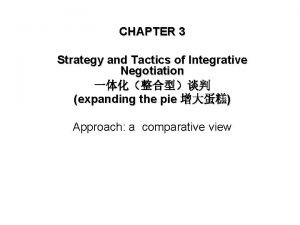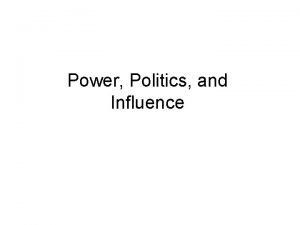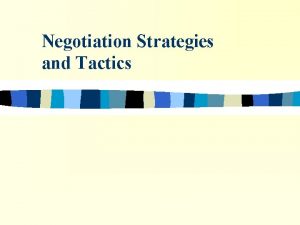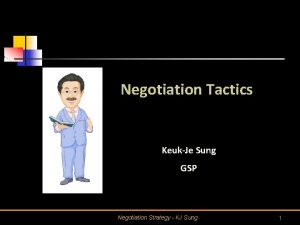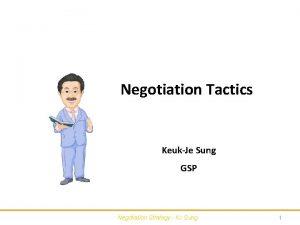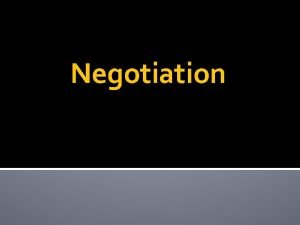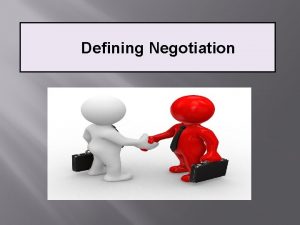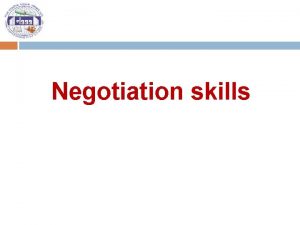STRATEGIES AND TACTICS OF NEGOTIATION HELEN PENG CONTENTS



















- Slides: 19

STRATEGIES AND TACTICS OF NEGOTIATION HELEN PENG

CONTENTS • Distributive Negotiation • Integrative Negotiation • Negotiation Types • Eight Key Strategies to Manage Customers Mindset

DISTRIBUTIVE NEGOTIATION • Strategy is concerned with mapping out the plan and basic policies to be followed in negotiation. • The strategies depend on the philosophy, business imperatives, technological vulnerability, public pressure, and political interferences etc. • Strategies change as per the demand of the situation-either it follows formal or informal channel. • Usually negotiator follows following strategies: 1. distributive negotiation 2. integrative negotiation Yield Accommodate Withdraw Compromise Soft contending Collaborate Hard contending Take it or leave it

DISTRIBUTIVE NEGOTIATION • Distributive negotiation takes place when the resources are fixed and limited and each individual/party wants to get a large share for itself. • The competitive negotiator views the negotiating world as one controlled by an egocentric self-interest. • Negotiators mark their true intents and needs by exaggerating emotions and demands and by exhibiting conflicting verbal and non-verbal cues. • Distributive bargaining generally takes place in case of a one time-relationship. • Some of the tactics used in distributive bargaining are described below: 1. Bluffing; 2. Delays; 3. Snow Job; 4. Temper Tantrums; 5. Nibble; 6. Limited Authority

DISTRIBUTIVE NEGOTIATION • In distributive bargaining, one’s gain is the most important issue. The tactics used can be irrational, emotional, or even unethical. • Three reasons why people behave unethically: 1. Profit motive-to get more than the other 2. A sense of competition-to win is most important at any cost. 3. Concern for justice-to be “fair” from one’s own point of view.

DISTRIBUTIVE NEGOTIATION • Slicing the Pie Fundamental Strategies 1. To push for a settlement close to the seller’s (unknown) resistance point, thereby yielding the largest part of the settlement range for the buyer. 2. To convince the seller to change her resistance point by influencing the seller’s beliefs about the value of the condo, and thereby increase the bargaining range. 3. If a negative settlement range exists, to convince the seller to reduce her resistance point to create a positive settlement range or to change his own resistance point to create an overlap. 4. To convince the seller to believe that his settlement is the best that is possible-not that it is all she can get, or that she is incapable of getting more, or that the buyer is winning by getting more. Ego satisfaction is often as important as achieving tangible objective.

The Bargaining Zone and the Negotiation Dance Every negotiator should know certain important principles when it comes to slicing the pie. First it is important to realize that the bargaining zone can be either positive or negative. Strategy 1: Assess your Best Alternative To Negotiated Agreement (BATNA) and improve it. Strategy 2: Determine Your Reservation Point, But Do Not Reveal It. Strategy 3: Research the Other Party’s BATNA and Estimate Their Reservation Point Strategy 4: Set High Aspirations (Be Realistic, But Optimistic) Strategy 5: Make the First Offer (If You Are Prepared) Strategy 6: Immediately Re-anchor if the Other Party Opens First Strategy 7: Plan your Concessions: Consider three things 1. The pattern of concessions 2. The magnitude of concessions 3. The timing of concessions Strategy 8: Use an objective-Appearing Rationale to Support your Offers Strategy 9: Appeal to Norms of Fairness Strategy 10: Do Not Fall for the “Even Split” Ploy

DISTRIBUTIVE NEGOTIATION The most commonly bothering questions 1. Should I reveal my reservation point? 2. Should I lie about my reservation point? 3. Should I try to manipulate the other party’s reservation point? 4. Should I make a “Final Offer” or commit to a position? Saving Face Saving face in a negotiation has been called “one of an individual’s most sacred possessions” Face is the value a person places on his/her public image, reputation, and status vis-à-vis other people in the negotiation. Direct threats to face in negotiation include making ultimatums, criticisms, challenges, and insults. Often, it is the mere presence of an audience that can make “saving face” of paramount importance for the negotiator.

DISTRIBUTIVE NEGOTIATION We suggest four avenues for escaping commitments: 1. Plan a Way out 2. Let it Die Silently 3. Restate the Commitment 4. Minimize the Damage

DISTRIBUTIVE NEGOTIATION Closing the Deal Wise-Pie-Slicing 1. Provide Alternatives 1. Consistency 2. Assume the close 3. Split the Difference 4. Exploding Offers 5. Sweeteners 2. Simplicity 3. Effectiveness 4. Justifiability 5. Consensus 6. Generalisability

INTEGRATIVE NEGOTIATION Ø Unlike in distributive negotiation, the focus in integrative negotiation is to agree on a mutually satisfying outcome, and hence by design it becomes a win-win kind of negotiation. Ø The negotiators need to safeguard against the following pitfalls: 1. There is no fixed pie. It could be expanded and/or utilized to the maximum advantage of all parties. 2. The process of negotiation can become non-relational. The focus may shift from issue to position, ego, and face saving. 3. Over confidence in one’s own position ma lead to neglecting the need of other people. Ø Integrative bargaining is difficult to achieve for various reasons. No one would like to be a loser, thus the parties try to get as much as possible from the negotiation situation. Ø Compromise takes place because the parties want to avoid conflict or extended negotiation.

INTEGRATIVE NEGOTIATION • Following beliefs would be conducive to the problem-solving approach: 1. Belief in the availability of a mutually acceptable solution that will achieve everyone's goals. 2. Belief in cooperation rather than competition. 3. Belief that everyone is of equal value-no status or power imbalance is involved. 4. Belief in the view expressed by others as legitimate statements of their position. 5. Belief that differences of opinion are helpful. 6. Belief in the trustworthiness of the other member. 7. Belief that the other party can compete, but chooses to cooperate.

INTEGRATIVE NEGOTIATION What is win-win negotiation Strategies that work WIN-WIN NEGOTIATION: EXPANDING THE PIE anyway? 1. Build trust and share information 1. Compromise 2. Ask diagnostic questions 2. Even split 3. Provide information 3. Feeling good 4. Building a relationship 5. Telltale signs of win-win potential 4. Unbundle the issue 5. Make package deals, not single issue offers 6. Make multiple offers simultaneously 7. Make the offers all tat the same time

INTEGRATIVE NEGOTIATION • • Structure contingency contracts by capitalizing on differences A strategic framework for reaching integrative agreements Resource Assessment Strategy for negotiation Why people are ineffective negotiators Faulty feedback Satisficing Self-Reinforcing Incompetence

INTEGRATIVE NEGOTIATION • Debunking Negotiation Myths Myth 1. Negotiations are fixed-sum Myth 2. You need to be either tough or soft Myth 3. Good Negotiators are Born Myth 4. Experience is a Great Teacher Myth 5. Good Negotiators Take Risks Myths 6. Good Negotiator rely on Intuition

INTEGRATIVE NEGOTIATION When you shouldn't negotiate ü When you’d lose the form ü When you’re sold out ü When the demands are unethical ü When you don’t care ü When you don’t have time ü When they act in bad faith ü When waiting would improve your position ü When you’re not prepared

l Skills for Negotiation l Taking Initiatives l Avoiding Negotiation Myths l Tactics for equals or betters l Approach l Saying Yes and No l General Tactics and Strategies for Negotiation l When to Say No p Self assessment l Tactics for Weak Positions p Assess the other party l Tactics p Assessment of situation l Negotiation Types l Tactics of Information l Important rules of conduct in Negotiations l How to Say No

EIGHT KEY STRATEGIES TO MANAGE CUSTOMERS MINDSET 1. Prepare by knowing your walkway and by building the number of variabes you can wor with during the negotiation 2. When under attack, listen 3. Keep track of the issues requiring discussion 4. Assert your company’s needs 5. Commit to a solution only after it’s certain to work for both parties 6. Save the hardest issues for last 7. Start high and concede slowly 8. Don’t be trapped by emotional blackmail

 Helen peng age
Helen peng age Helen peng
Helen peng Strategy and tactics of integrative negotiation
Strategy and tactics of integrative negotiation Microsoft negotiation tactics
Microsoft negotiation tactics Eba negotiation tactics
Eba negotiation tactics Unethical political tactics and strategies
Unethical political tactics and strategies Volleyball setting chart
Volleyball setting chart Function of public relations
Function of public relations Sequencing strategies and tactics
Sequencing strategies and tactics Helen midtown computer solutions helen speaking
Helen midtown computer solutions helen speaking Helen midtown computer solutions helen speaking
Helen midtown computer solutions helen speaking Nyit blackboard
Nyit blackboard Four stages of negotiation
Four stages of negotiation Wang peng li you
Wang peng li you Dolphin and the mermaid game
Dolphin and the mermaid game Peng robinson equation
Peng robinson equation Persamaan peng robinson
Persamaan peng robinson Aspen lum
Aspen lum Changnan peng
Changnan peng Memudaratkan
Memudaratkan


